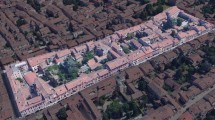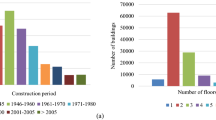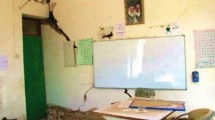Abstract
This study focuses on the evaluation of seismic safety of unreinforced masonry buildings in Turkey by using fragility curves generated for two behavior modes of load bearing walls: in-plane and out-of-plane. During generation of fragility curves, a force-based approach has been used. There exist two limit states in terms of base shear strength for in-plane behavior mode and flexural strength for out-of-plane behavior mode. To assess the seismic vulnerability of unreinforced masonry buildings in Turkey, fragility curves generated for in-plane behavior were verified by the observed damage during the 1995 Dinar (Turkey) earthquake and fragility curves generated for out-of-plane behavior were verified by the observed damage during the 2010 Elazığ (Turkey) earthquake. The verification results reveal that the proposed fragility-based procedure can provide an alternative for the seismic safety evaluation of unreinforced masonry buildings in Turkey. Using this procedure, it becomes possible to investigate a large population of masonry buildings located in regions of high seismic risk in a short period of time. The obtained results are valuable in the sense that they can be used as a database during the development of strategies for pre-earthquake planning and risk mitigation for earthquake prone regions of Turkey.


















Similar content being viewed by others
References
Akkar S, Aldemir A, Askan A, Bakır S, Canbay E, Demirel O, Erberik MA, Gülerce Z, Gülkan P, Kalkan E, Prakash S, Sandıkkaya MA, Sevilgen V, Ugurhan B, Yenier E (2011) 8 March 2010 Elazığ–Kovancılar (Turkey) earthquake: observations on ground motions and building damage. Seismol Res Lett 82(1):42–58
Al Shawa O, de Felice G, Mauro A, Sorrentino L (2012) Out-of-plane seismic behaviour of rocking masonry walls. Earthq Eng Struct Dyn 41:949–968
Bernardini A, Gori R, Modena C (1990) An application of coupled analytical models and experiential knowledge for seismic vulnerability analyses of masonry buildings. Eng Aspects Earthq Phenom 3:161–180
Boore DM, Atkinson GM (2008) Ground motion prediction equations for the average horizontal component of PGA, PGV and 5%-damped PSA at spectral periods between 0.01 s and 10.0 s. Earthq Spectra 24(1):99–138
Chiou BS-J, Youngs RR (2008) An NGA model for the average horizontal component of peak ground motion and response spectra. Earthq Spectra 24(1):173–215
D’Ayala DF (2005) Force and displacement based vulnerability assessment for traditional buildings. Bull Earthq Eng 3:235–265
de Felice G (2009) Valutazione della capacità sismica di pareti rispetto ad azioni fuori dal piano. ReLUIS Project, 3rd year report, Annex 1.2-UR09-1
Doherty KT, Griffith MC, Lam N, Wilson J (2002) Displacement-based seismic analysis for out-of-plane bending of unreinforced masonry walls. Earthq Eng Struct Dyn 31:833–850
EN 1998-1 (2005) Eurocode 8: design of structures for earthquake resistance, Part 1: general rules, seismic actions and rules for buildings, CEN
Erberik MA (2008) Generation of fragility curves for Turkish masonry buildings considering in-plane failure modes. Earthq Eng Struct Dyn 37:387–405
Griffith MC, Magenes G, Melis G, Picchi L (2003) Evaluation of out-of-plane stability of unreinforced masonry walls subjected to seismic excitation. J Earthq Eng 7(S1):141–169
Housner GW (1963) The behavior of inverted pendulum structures during earthquakes. Bull Seismol Soc Am 53:403–417
Lagomarsino S, Magenes G (2009) Evaluation and reduction of the vulnerability of masonry buildings. In: Manfredi G, Dolce M (eds) The state of earthquake engineering research in Italy: the ReLUIS-DPC 2005–2008 Project, pp 1–50
Lang K, Bachmann H (2003) On the seismic vulnerability of existing unreinforced masonry buildings. J Earthq Eng 7(3):407–426
Makris N, Konstantinidis D (2003) The rocking spectrum and the limitations of practical design methodologies. Earthq Eng Struct Dyn 32:265–289
McKay MD, Conover WJ, Beckman RJ (1979) A comparison of three methods for selecting values of input variables in the analysis of output from a computer code. Technometrics 221:239–245
Menon A, Magenes G (2008) Out-of-plane seismic response of unreinforced masonry: definition of seismic input. Research Report ROSE-2008/04, Rose School, EUCENTRE, Pavia, Italy
NTC08 (2008) Norme tecniche per le costruzioni. Ministero delle Infrastrutture e dei Trasporti, Decreto Ministeriale del 14 gennaio 2008, Supplemento ordinario alla G.U. n. 29 del 4 febbraio 2008 (in Italian), and relevant instructions “Circolare del Ministero delle Infrastrutture e dei Trasporti, No. 617”, 2009
Park J, Towashiraporn P, Craig JI, Goodno BJ (2009) Seismic fragility analysis of low-rise unreinforced masonry structures. Eng Struct 31:125–137
Paulay T, Priestley MJN (1992) Seismic design of reinforced concrete and masonry buildings. Wiley, New York
Restrepo-Vélez LF, Magenes G (2004a) Simplified procedure for the seismic risk assessment of unreinforced masonry buildings. In: Proceedings of the 13th world conference on earthquake engineering, Vancouver, Paper No: 2561 (in CD-ROM)
Restrepo-Vélez LF, Magenes G (2004b) Experimental testing in support of a mechanics-based procedure for the seismic risk evaluation of unreinforced masonry buildings. International Seminar (SAHC) “Structural Analysis of Historical Constructions”, Balkema, Rotterdam
Sharif I, Meisl CS, Elwood KJ (2007) Assessment of ASCE 41 height-to-thickness ratio limits for URM walls. Earthq Spectra 23(4):893–908
Shinozuka M, Feng MQ, Lee J, Naganuma T (2000) Statistical analysis of fragility curves. J Eng Mech ASCE 126(12):1224–1231
Simsir C (2004) Influence of diaphragm flexibility on the out-of-plane dynamic response of unreinforced masonry walls. Ph.D. Dissertation, Department of Civil and Environmental Engineering, University of Illinois at Urbana-Champaign
Turkish Earthquake Code (2007) Specification for structures to be built in disaster areas. TEC-07. Ankara, Turkey: Turkish Ministry of Public Works and Settlement
Wen YK, Ellingwood BR, Bracci J (2004) Vulnerability function framework for consequence-based engineering. Mid-America Earthquake Center, CD Release 04-04
Yılmaz N, Uran T (2010) 8 March 2010 Elazığ earthquakes. Earthquake Department, Disaster and Emergency Management Presidency, Ankara. Technical Report
Zor E, Sandvol E, Xie J, Türkelli N, Mitchell B, Gasanov AH, Yetirmishli G (2007) Crustal structure within the Turkish plateau and surrounding regions. Bull Seismol Soc Am 97:151–161
Author information
Authors and Affiliations
Corresponding author
Rights and permissions
About this article
Cite this article
Ceran, H.B., Erberik, M.A. Effect of out-of-plane behavior on seismic fragility of masonry buildings in Turkey. Bull Earthquake Eng 11, 1775–1795 (2013). https://doi.org/10.1007/s10518-013-9449-0
Received:
Accepted:
Published:
Issue Date:
DOI: https://doi.org/10.1007/s10518-013-9449-0




